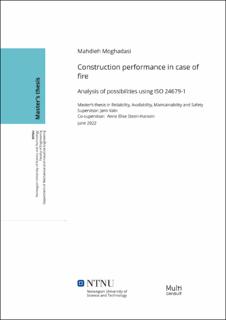| dc.description.abstract | There are different ways to design fire safety of the structure. Traditionally, prescriptive requirements set like building codes, building regulations and related standards were popular among fire safety engineers. However, due to increasing the opportunities to innovation, aesthetics and optimization of the spaces in the structure, performance-based design has received more attentions. In addition, this methodology is more user friendly than prescriptive requirements. Several organizations provide performance- based design guidelines such as BSI, ISO, IEFG, SFPE.
Aim of this project is to study provided methodology in ISO 24679-1: Fire safety engineering — Performance of structures in fire — Part1: General, which was considered performance-based design. The topic is defined by the Multiconsult Co. In this regard, the literature review is divided into two parts; investigating performed studies with concentration on assessing the applicability of provided methodology in ISO 24679-1 and investigating of those studies which took inspiration or used a part of related technical reports.
In the following, the first four steps of the methodology are applied to the NOVA spectrum (a steel framed structure of multi-functional arena with 5 main halls) as a case study. Visiting the place revealed this arena in some sections has second floors for office work. This arena with total 46,385 m2 gross area had 5 halls for events and 3 halls for storage in north wings. Multiconsult Co suggested focusing on the hall B with 7274 m2 area for further study.
In this regard, fuel load calculation related to accidental condition (in our case fire accident) is performed. The fuel load is identified based on internal content and occupancy type, and it is calculated 118.57 MJ⁄m^2 and 730 MJ⁄m^2 respectively. Then, appropriate equations for calculation of combinational action is extracted and the result is 3,75 kN⁄m^2 . All these calculations are performed by having estimation on internal content and permanent and live loads.
To have ideas regarding fire scenarios a qualitative Event Tree is provided. A worst case in fire scenario is selected and fire design calculation is done for this part. In next step, by considering the literature study, a procedure is proposed for implementing the provided methodology in ISO 24679-1.
By working on the case study, a gap regarding fire risk assessment was found. Therefore, a comparison between two fire risk assessments regulation, namely ISO 16732-1 Fire safety engineering — Fire risk assessment — Part 1: General, and NS 3901.E:2012 Requirements for risk assessment of fire in construction works is performed to provide an overview on risk assessment part. | |
